I. Introduction
In the era of globalization, local identities are teetering on the brink of extinction. This is possibly due to collective memories not being concretely recorded anywhere. As a result, the authenticity of the memories is limited, and communities or even countries tend to resemble each other.
Taking that into consideration, the Memory project aims to promote the use of authentic information as an inspiration in various sectors, contributing to the local development as well as to develop the skills of the youth workers to work with local people to collect memories and discover collective identities that can act as common points of reference in the past.
In this project, each community-partner in Greece, Italy, Peru and Vietnam goes through several phases to get trained then identify, valorise and promote local collective memories. So far, the four teams have gone through the phase of valorising the memories in each country and have got noticeable achievements.
This is a report from CSDS (Vietnam) to provide information about the process of valorising previously identified memories in Hua Tat Village, Son La province.
II. Community description
Hua Tat Village, located in Van Ho, Son La (Northern Vietnam), is a beautiful village surrounded by lush, breath-taking greenery. It is a 3 to 4-hour drive from Hanoi to the village, which is located 5 minutes away from Road 6, the main road to Moc Chau Plateau. There are 150 households (June, 2019) who are mostly from the Hmong tribe. Most of them are farmers who grow crops such as vegetables, fruits, corn, plum and tea plants.
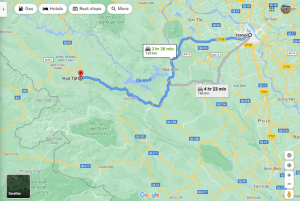
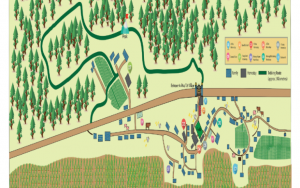
III. Ten memories with their valorisation strategies
- Paper-making
Paper making is a handicraft that has been passed down generation after generation in Hua Tat. The papers here are made for domestic and cultural purposes which you can’t find anywhere else. And by any means, the process of Hmong paper making is absolutely meticulous. The process of paper generally involves 4 main steps: collecting, stewing, soaking and drying, adding up to the whole month to complete the process. It is usually done once a year between July and August.
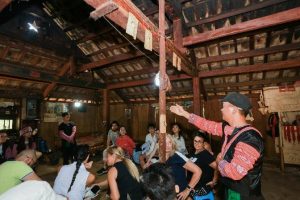
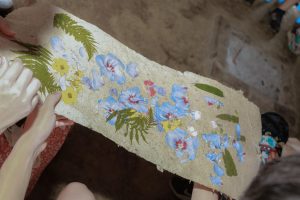
First look at Paper-making introduction session
With the help of team Greece and Italy coming to Vietnam, we shuffled ourselves in groups to experiment several strategies to valorise this memory, namely film, landmark, urban art, or senses. Each group created their own product using one of the strategies and presented it to everyone. Of the four strategies, film was deemed to be the most suitable one due to its advantages in recording and illustrating a process and its convenience. Documentary was chosen to be the suitable genre of film for we wanted the film to be informative and a little formal.
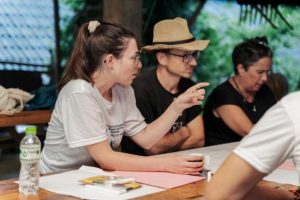
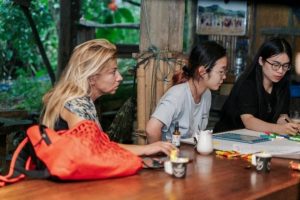
Teamwork
The film group went to trainer A Của’s house, where the workshop was carried out, observed the making process and brained-storm about how the story would play out. After that, with the help of A Của, also the protagonist of the film, we filmed the whole process with his narration about the steps, some tips, things to avoid and related information about paper-making occupation. The film materials were then sequenced, processed, edited and rendered with English subtitles, creating a wonderful piece of documentary about paper-making.
Here’s the link to the documentary.
Moreover, since it was a workshop where participants can learn about the occupation and get more information, it would also be a great strategy to valorise the memory. The workshop provides hands-on experience of doing some small steps in the process, such as chopping and splitting bamboo, squashing and filtering bamboo pulp, designing and spreading refined bamboo pulp, and peeling out finished products.
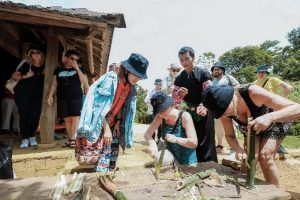
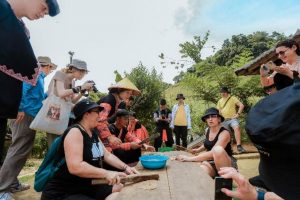
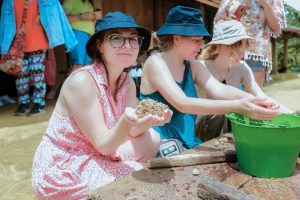
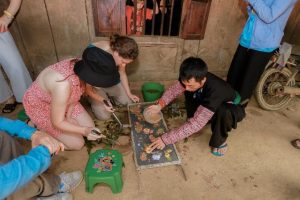
Workshop of making bamboo paper
- Wife-catching
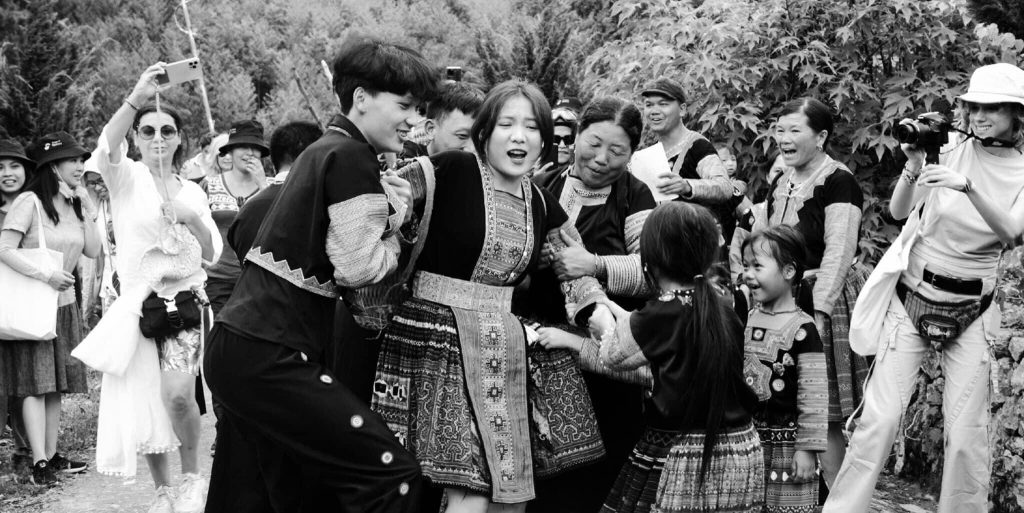
Wife-catching practice
The custom of Wife-catching is a unique cultural feature in the marriage of the Hmong people. The custom of “capturing a wife” can also take place for many reasons, for example, the boy likes the girl but not the other way around; however, these cases only happened in the past, under feudal society. About 5-6 years ago, the custom of catching a wife has gradually disappeared because young people can get to know each other via the Internet; only a few of them keep that activity going.
The golden time to “steal” or “capture” a girl is when she goes out, feeds the pigs, etc. or when there is no one else at home. If the girl is captured, she has to stay at the boy’s house for 3 days, then a member of the boy’s family would go back to the girl’s house to ask for marriage. If she doesn’t give her consent to marry the person who captured her, however, then after 3 days, it would be fine for the girl to get married with another because she is not discriminated against by the community.
With the notion that the girl does not actively follow the boy, people believe that when there is a dispute, the girl would have a reason as “I didn’t follow you, I was captured”. Young people often invite friends to join them in catching their lovers. When the girl’s family tries to save the girl, the boy’s friends rush to block the blow so that the boy can bring the girl home.
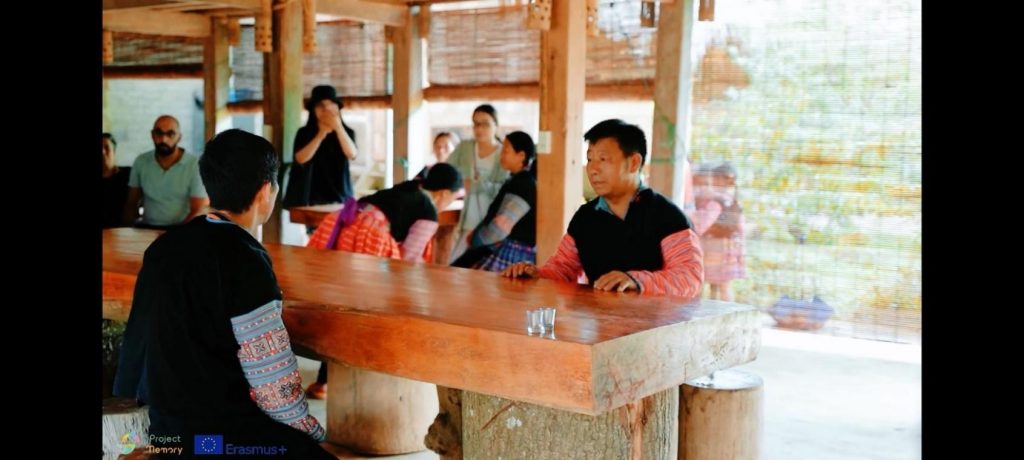
Negotiation between representatives of the two families
For this memory, we also got the assistant from the Greek and Italian teams to experiment some other strategies, such as, photo collage, podcast, comic, and treasure hunt, which, as amazing as they sounded, produced some wonderful results. Moreover, the whole experience of seeing first-hand the wife-catching tradition was done with a guided tour since the tradition has now ceased to be practiced.
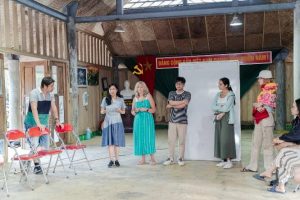
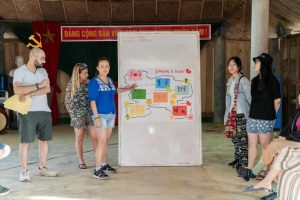
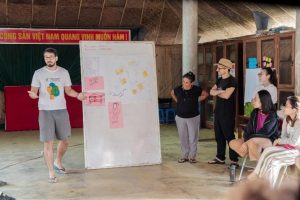
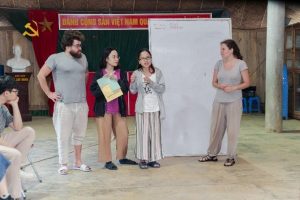
Four teams, four strategies
It was a play, with the characters played by the locals themselves – the boy, the girl, their families, that helped participants experience and understand the tradition. Each act was well recreated, following the boy and girl to the scenes where it usually had happened in the past. After the play, we also had a discussion and Q&A session between the participants and the locals to dig deeper into and unravel any confusion about the tradition. The guided tour indeed provided the liveliest way possible for the participants to fully understand the practice.
Although the four strategies were later considered not suitable to effectively valorise this memory due to the community’s nature of being rather traditional and reserved, and the inconvenience of each strategy, fortunately, the guided tour was recorded well enough to create a video, which, combining with the guided tour itself, can be used as the valorising strategies.
Here’s the link to the video, and the following is some information about the guided tour. The play includes the following scenes: the dialog between the two lovers agreeing on practicing the tradition before marriage, the capturing scene where the girl worked, the resistance the boy met when the girl’s family found out she’s being captured, the announcement from the boy’s uncle to the girl’s family; the agreement upon pre-marriage ceremony, and the acceptance the girl’s father give to the kneeling boy. Participants follow the storyline to each place and witness the story play out.
- Hmong language
Vietnam has a total of 54 ethnic groups and each of them or group of ethnic groups has their own language and so do the Hmong people. They have their own spoken language, yet not a written one.
People in Hua Tat all know how to speak Hmong and they use this language to communicate with each other. For them, their mother tongue is taught informally through practising in daily life. The children here learn Vietnamese/national language at school, but when they return home, they will still communicate with their family members in the Hmong language.
Currently, there are many types of Hmong script in the world, but the most popular and convenient is the script that the Hmong people in Vietnam are used to calling the International Hmong script (Romanized Popular Alphabet – RPA or Hmong RPA).
When Hmong language is still used in daily communication within the community, this language is still being preserved. At that time, the Hmong culture was also maintained through the use of language to convey cultural values and information passed on from generation to generation of people in the community.
For outsiders, listening to Hmong is an interesting experience, not only because it is very different from Vietnamese, but also a way for the Vietnamese to partly feel the unique identity of the locals. In order to bring the Hmong language closer to visitors, the valorization of this language can be done through the Hmong lessons. By participating in a basic Hmong class for about 1 hour and 30 minutes taught by the indigenous people themselves, learners can learn basic self-introduction and communication sentences, to feel more connected with the Hmong people and their land.
In one Hmong lesson, learners will have the first 45 minutes to listen and pronounce according to the instructor with basic sentence patterns such as Hello, Goodbye, What’s your name?, How old are you?, My name is…, etc. Then the last 45 minutes will be for the learners to practice on their own to memorise and practice it with the Hmong people in the area. After seeing that the Hmong could understand what they were saying, the learners might feel very delighted and be eager to practice and learn Hmong more to communicate in order to become closer with the local people.
Here ís the Link of a record people practising Hmong language together as a part of the Hmong Lessons
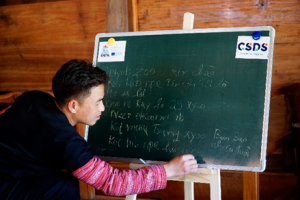
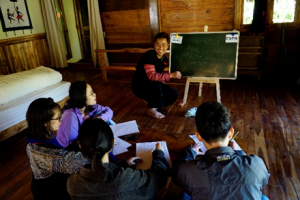
- Homestay model
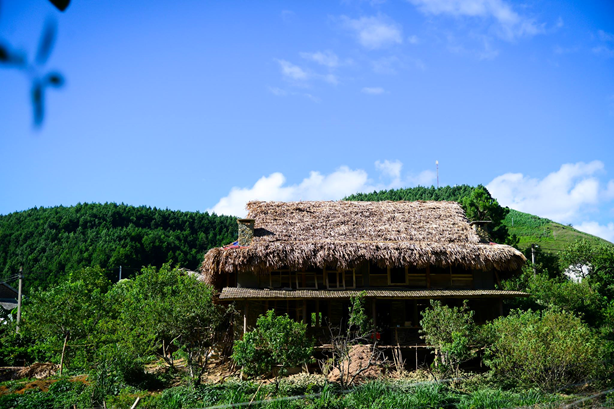
The homestay from afar, in the middle of the mountains and the sky
Homestay model is not a never-before-seen type of tourist service in Vietnam. But it was something the people in Hua Tạt had not even thought of doing 9 years ago. And now it slowly becomes significant when people come to the village.
The first original homestay model in Hua Tạt was started by Tráng A Chu. He was the first person in the village to achieve a bachelor degree, not to mention by Hanoi University of Science and Technology – one of the most prestigious universities in Vietnam. But after graduation, he did not choose to stay in Hanoi, but went back to the community and decided to make a living right on his motherland.
Even though he had learnt intensively about the model and the direction of Mộc Châu – a nearby city that had ongoing blooming tourism at that moment, he still encountered many great challenges – the location of the village, the costs, the mentality of the people of “staying with what-has-always-been”. But he was not discouraged, so he and his family decided to give up his farm to build the largest house in the village and it has been opened for visitors since 2013.
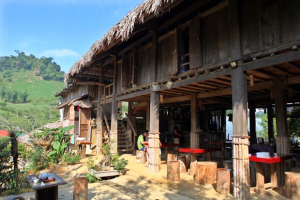
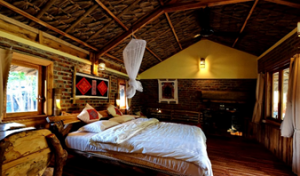
Hmong culture is preserved in the homestay
The owner wants to bring in the cultural uniqueness of his own people to the homestay, therefore the house has many of Hmong features: a stilt house, with nearly all of the furniture are made from wood, decorated with a lot of colorful Hmong traditional fabric,… Not only that, the food mainly is seasonal and the delicacy of the area, harvested from their own land and served to the table in the same day. This not only brings more regular income to the farmers but also brings the freshness to the visitors’ meals.
The homestay combines the home atmosphere in the stay, as it is run by the A Chu’s family themselves. The family members do house chores, cook, clean and wash, embroider, fix things in the house,… Furthermore, he and his wife adopted some children in the village to stay with them because their parents went to prison for drugs, they fed them, and put them in school and the children became family members too.
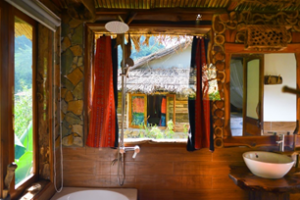
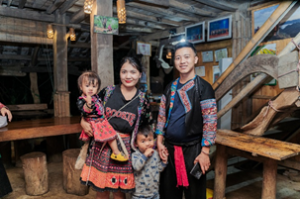
The cozy atmosphere of the homestay
Our valorized strategy is to recreate the cozy, hospitable atmosphere when the visitors stay at the homestay by putting them in a video involving the senses of the human body – with the actual recording visual and sound. The video captures how each corner of the homestay felt like: with sunlight peaks through the windows to land gently on the beds, how the stairs slowly creek by each rhythm of the footsteps, or how the hands run smoothly on the stair handle, the birds chirping while the cooking creates a crackling sound in the kitchen to present delicious food later on the wooden table; even the activities are organized for visitors by homestay like “múa xoè” (Hmong’s traditional dance) is also recorded. This is not only to show and promote the traditional features of the Hmong people in every corner of the house, but also of their everyday life.
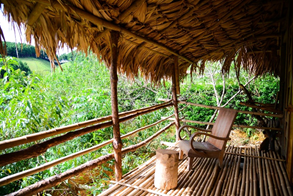

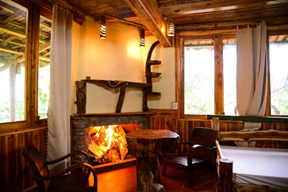
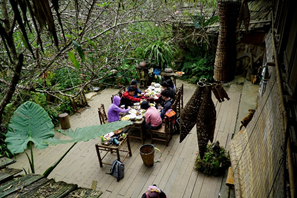
Feel the atmosphere through senses
Cinematography is a suitable method to valorized this memory because when it is promoted on social media, the tourists that haven’t had a chance to visit would be curious and want to know more about the homestay. And to those who have been there, it is also a way for them to remind them of the memory of the homestay, how they feel while staying there.
The video can be found here in this link.
- Making Bánh Dày
The Hmong people consider “Bánh Dày”, a kind of sticky rice cake, to be a symbol of the sun and the moon, which are the origin and vitality of humans and everything on earth. The Hmong people make these sticky rice cakes during the New Year Festival, Tet, and after the harvest.
The Hmong have their own way of making and enjoying Banh Day. Since this is a cuisine, cooking is the most appropriate and effective method when visitors can not only participate in most of the steps in the process of creating but also enjoy it directly during the meal. .
Making Banh Day includes several exciting stages in which each can involve visitors in the experience such as pounding the steamed rice quickly and hard with a wooden pestle to make the steamed rice smooth or skillfully squeeze the minced rice into a fistful then put it in the basket.
Banh Day remains its best taste when made during the day and eaten when still hot. To fully enjoy the aroma and sweet taste of Banh Day, they usually do two types of methods: fry or bake it. In addition, the most perfect way to enjoy this dish is to dip it with sugar cane powder or wild honey. All ingredients are locally based in Hua Tạt.
Banh Day making workshops are very feasible to implement whether for large or small groups of tourists since everyone can participate at any step they want or take turns experiencing each activity. By being directly involved in the process of making and using many senses when enjoying this typical cuisine, visitors will love and remember more about the land and people of Hua Tat.
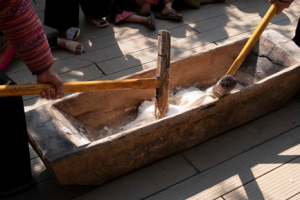
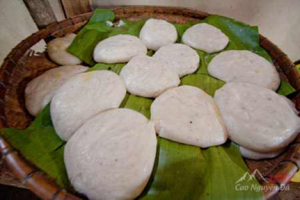
- Drawing designs on fabrics with beeswax
Hmong people learned the skills of Hmong batik when they were young and have been practicing it ever since. There are 4 steps to do in the whole process:
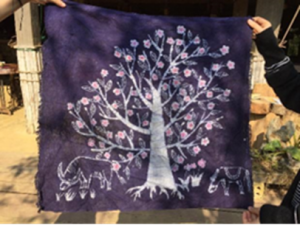
Step 1: Harvesting of materials – Beeswax is harvested from the forest from June to August. Roughly 30 kilograms worth of beeswax can be obtained during this period. The pigment for the fabric dye is obtained by boiling leaves from paperbark trees.
Step 2: Material preparation – Quicklime is added into the dye obtained from the paperbark leaves. The preparation of the fabric dye mixture takes roughly 3 weeks from the collection of ingredients. The beeswax is melted before using it to draw on the fabric.
Step 3: Designing the fabric – to create patterns on the fabric, iron tools are dipped in the melted beeswax and used to trace designs on the cloth.
Step 4: Soaking in dye mixture – the cloth must be dyed 3 times per day in a week.
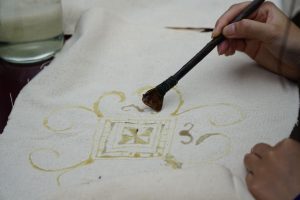
Previously the Hmong kept the secret of this art, but now workshops have been organized to welcome the outsiders to explore this traditional art form. Each workshop will be a relaxed atmosphere for beginners to explore and experiment, they will be amazed at what they will achieve! Each will make A5 samples to get used to the various techniques, then onto your final piece – approx. 16”x16”. And during the workshop, the local tutor will be always welcoming and give many useful tips to help the participants make progress with this technique.
- Hmong music
The Hmong language is tonal, there is a close connection between Hmong music and the spoken language. Music is an important part of Hmong life, played for entertainment, for welcoming guests, and at weddings, etc.
Being aware of their responsibilities and role in preserving literary values and promoting the cultural values of their own community, so that the culture will not be lost but will be promoted in today’s life, the Hmong people not only sing or play their music in special occasion but also organize the small live show as an opportunity for the visitors to experience the melody and the beauty of Hmong music. All the shows or festivals have music performances that also contribute to the desire to make even the young local people more enjoy their folk songs, inspired to learn and practice traditional music arts in the current social environment. By sharing the music with the outsiders, Hmong music can reach many people
A mini festival was held to recreate the typical activities in the festival of the Hmong, in which music plays a big part in creating the atmosphere and engaging the people.
Link: https://www.youtube.com/watch?v=Bc8J_TrJWKA
- “Cái bế”
One of the most significant characteristics of Hmong people in Hua Tạt is that they are born and live with the mountains throughout their life. Therefore, they make a living mainly relying on agriculture. There is this saying “No mountain is higher than the Hmong’ knees”, to prove that they can live well and harmoniously with whatever the height of any mountain. To do that, they have to create a tool which is easy for them to carry and cross any type of rough landscape, that is an object called “Cái bế”.
The “Story of cái bế”
Cái bế is used in many aspects in Hmong people’s daily life: from storing the wood logs for making the fire, carrying food while they go to the market or go farming on the mountain slopes, to becoming a cradle for the baby behind mother’s back.
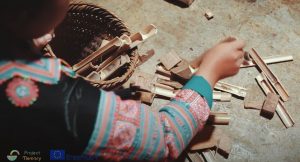
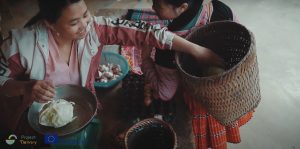
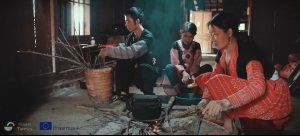
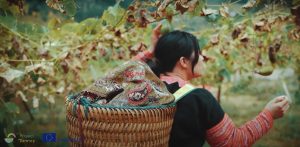
Cái bế serves many functions in everyday’s life
Cái bế even is present in their spiritual life: in family’s altar, ceremonies, festivals,… in weddings, Tet, funerals and making houses, forest offerings… In those rituals, cái bế is used by the Hmong people to store offerings, it is considered as a symbol of fidelity and the desire for a full and happy life. It is also considered as a piece of jewellery, while the women carry it on their backs, it represents the beauty and strength of Hmong women.
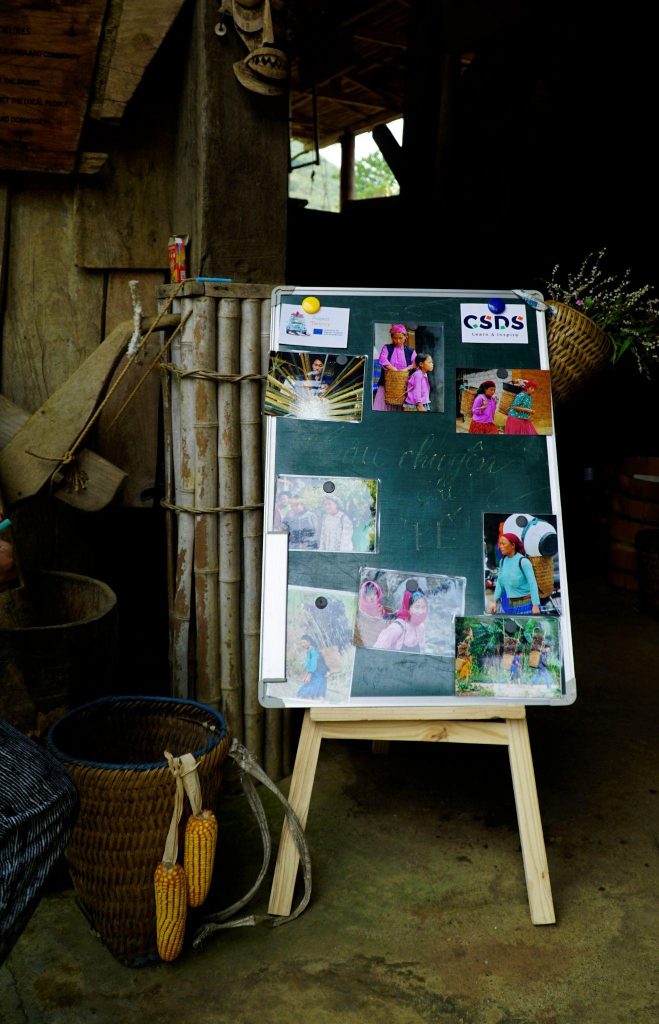 Our valorized strategy is storytelling by the means of cinematography, to tell a story about how Cái bế has gone from generations to generations and still is being kept in modern days. The video can be found here in this link. The story starts from when a baby is born, cái bế has followed her on the mother’s back at the sunny fields to when the baby enters adulthood then has the family of her own, cái bế is always there with every step of their life. The journey is led by a lullaby, sung by a mother who is calming a child to fall asleep in both Hmong language and Kinh language. This serves as a means of spreading the Hmong language and also it can be understood to the Vietnamese general public. In the making of the film, we incorporated elements that are very familiar to Hmong people in every scene: the fields on the hill, the stilt house, the colorful clothings, the traditional instruments and day-to-day objects,… The characters are also from the Hua Tat community.
Our valorized strategy is storytelling by the means of cinematography, to tell a story about how Cái bế has gone from generations to generations and still is being kept in modern days. The video can be found here in this link. The story starts from when a baby is born, cái bế has followed her on the mother’s back at the sunny fields to when the baby enters adulthood then has the family of her own, cái bế is always there with every step of their life. The journey is led by a lullaby, sung by a mother who is calming a child to fall asleep in both Hmong language and Kinh language. This serves as a means of spreading the Hmong language and also it can be understood to the Vietnamese general public. In the making of the film, we incorporated elements that are very familiar to Hmong people in every scene: the fields on the hill, the stilt house, the colorful clothings, the traditional instruments and day-to-day objects,… The characters are also from the Hua Tat community.
Furthermore, we also make a photo collage of cái bế in Hmong people’ daily lives with a QR code to lead to the “Story of cái bế” video. They are presented as a checkpoint location in the entrance door of the homestay. When the visitors stay in, through this checkpoint, they can have a chance to get to know more about this significant object and its meaning to Hmong people. Beside that, the checkpoint is decorated with the actual ones made by the locals and with the owner’s contact number, so the visitors could have a look and if they want they can buy them as souvenirs for themselves and loved ones – when they can see it has many functions, such as a basket for flowers, for storing food and vegetables,… This also helps to promote local businesses and keep this traditional art alive, since mostly the elderly people in the village know how to fabricate it, so the art slowly gets lost in younger generations.
9. Hmong’s agriculture
Agriculture and farming are the main occupation of people in Hua Tat Village. Before 2013-2014, Hua Tat local people mainly grew maize, arrowroot and upland rice. Then they switched to fruit trees such as plums and peaches. Since around 2015, when they realized that vegetables and fruits have better economic value, they have grown them on a large scale.
The area is divided into different parts with different types of fruit trees, vegetables and seasonal crops. The goal is to maintain year-round production. In spring – summer, there are plums, peach blossoms, leafy vegetables, green beans; in the cold season, there are strawberries, oranges, tangerines, avocados, tomatoes, chayotes, pumpkins and winter melons, etc. All year round, people take care of perennial fruit trees, raise cows, buffaloes, pigs and chickens, etc.
The season of growing vegetables in Hua Tat is opposite to the vegetable season in the lowlands, otherwise, Hua Tat vegetables would be hard to sell due to other competitors. On average, each day Van Ho and Moc Chau districts (also in Son La) harvest 600-800 tons of vegetables and transport them to Hanoi and other provinces for consumption.
For this memory, we figured that a workshop about farming would be best to valorise this memory for it convey the meaning of each farming activity through teaching and participants can experience farming first hand to really value the occupation. Therefore, we went back to Hua Tat to organize an experimental workshop about farming and agriculture in Hua Tat and came up with a tentative schedule for the workshop. Further adjustment is needed for perfecting the workshop. The following agenda can be used for agriculture all over Vietnam in general, and in Hua Tat to valorise the memory in particular.
The schedule includes:
|
TIME |
ACTIVITY |
|
10min |
Walking to and introducing the farming areas |
|
20min |
Plowing the land and cutting the grass |
|
10min |
Feeding the livestocks |
|
15min |
Fertilize the plants using livestocks’ poop |
|
10min |
Watering the plants |
|
20min |
Picking raw and fresh vegetables from trees at the farming area |
|
5min |
Conclusion and lessons |
|
Total: 1h30min |
|
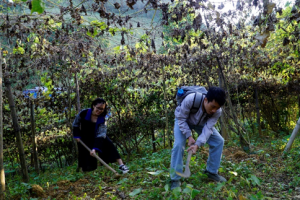
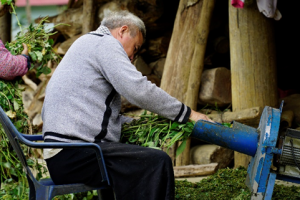
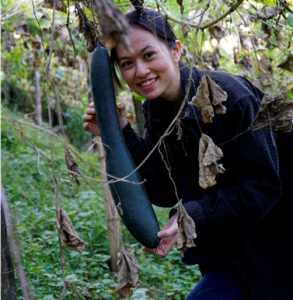
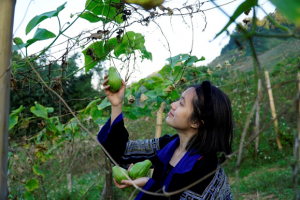
People coming to Hua Tat to experiencing its farming culture
Then after the tour, the visitors can enjoy what they have harvested from the garden right to table. They will taste the freshness in every ingredient and feel a sense of accomplishment, not to mention each dish will contain a story, an experience that they collected while working in the farming area.
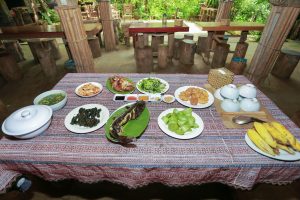
From the local ingredients to local delicacies
10. Shaman
In the Hmong culture, shamans play an essential role in the Hmong community. The shaman’s mission is to communicate with the spiritual world to bring back direct and reliable information to the Hmong community.
The position of a shaman is not inherited but chosen by the spirits, manifesting through trails experienced by those chosen. Chosen people are guided by elder shamans for at least three years until they are able to perform the rituals themselves. A Của is also one of the rare shaman of the village. The transfer of the shaman’s knowledge and skills is entirely oral, as the Hmong people nowadays do not use much of the language’s written form. Therefore, not everyone gets to become a shaman. They are chosen by the spirits to become an intermediary between the spiritual and the physical world. Shamans are the only ones who can perform certain ceremonies and rituals, such as, healing ritual, soul calling ritual, burial ritual, animal scarification, etc.
For A Của specifically, his grandfather was also a shaman, and he taught him in many years before he became a real one. He shared that he was chosen by the spirits from a young age, and he figured out his destiny then. His main job is to do healing rituals and soul calling rituals.
As we are proposing, this memory will be best valorised with objects mapping. We had a short interview of A Của talking about his role being a shaman and the role of shaman in general. After that, we selected the objects that represent him as the shaman and created a map with photos of those objects through which describes what the shaman does in each ritual or each activity in a series, which is written in the back of each photo. The final map or diagram is hung in A Chu homestay, where there often are a lot of tourists and people coming to Hua Tat to experience Hmong culture, making it a good place to display the map.
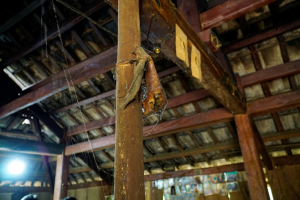
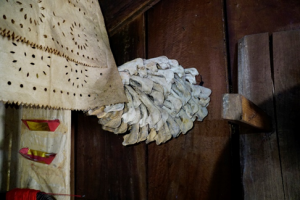
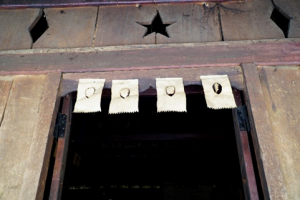
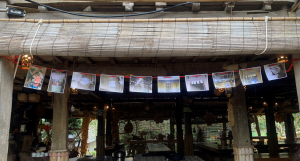
Some objects in the series
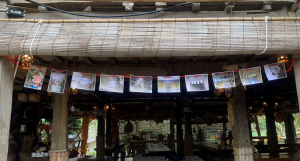
Final mapping
With this set up, the tourists and people coming here can listen to the storytelling from the homestay as well as read the information about shaman to learn about a very special role of Hmong people.
